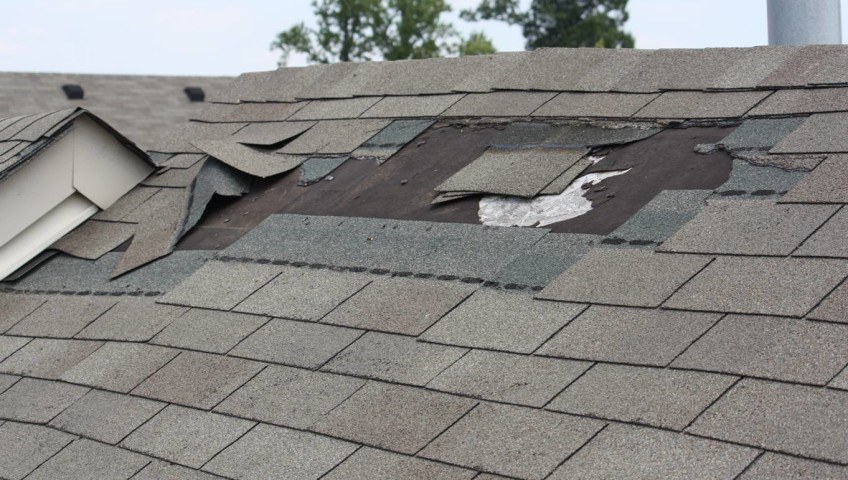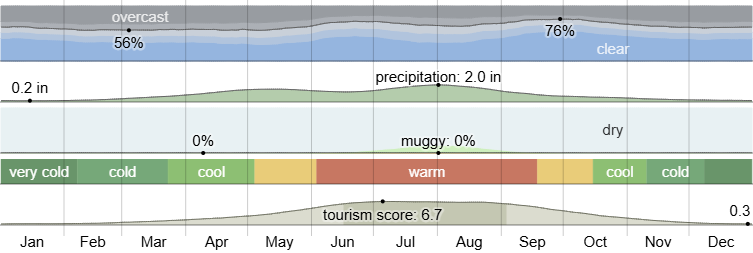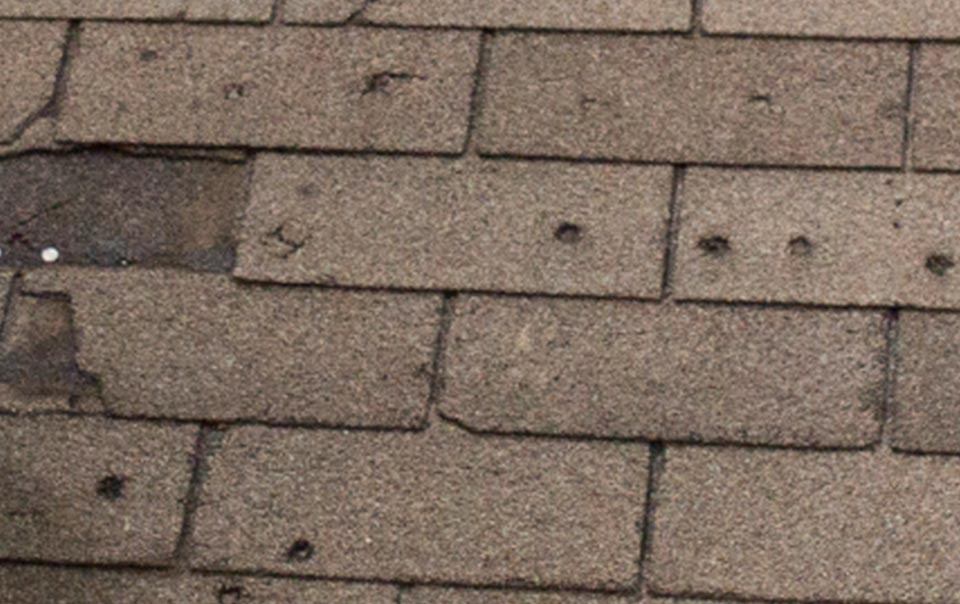Colorado is known for extreme weather. From the spring storms to the August wind gusts, hail is always a possibility in the Springs. In fact, in 2016, Colorado Springs was victim to the 6th most damaging hail storm the state has ever seen. When hail hits, the roof on your home is first to get damaged. If your house has been in the middle of a hail storm lately, you might have received hail damage on your roof.
A good method to find out if your roof has potential hail damage is to access the outdoor area around your home. If the surrounding flowers, cars, or windows are damaged, chances are very high that your roof sustained damage as well. However, keep in mind that damage to your roof may not be “visible.” In fact, it may not even become a problem until two or three years after a few cycles of hail storms. If it’s apparent that the neighborhood has hail damage, however, you can go ahead and perform your own preliminary inspection of your roof.
Cheyenne Mountain Roofing is your top-rated Colorado Springs hail damage roof repair experts. If you have experienced hail damage in the Colorado Springs area, contact our hail damage roof repair team at (719) 322-4659 or fill out our contact form and someone from our team will get back to you shortly. We look forward to working with you and helping you through this frustrating time.
How Does Hail Damage Affect Your Colorado Roof?
Your roof serves as the barrier between the outside weather and the interior of your home. It helps cover you from rain, shield you from wind, regulates the temperature inside your house, and so much more. Even though your roof is built to protect you from so much, it is still vulnerable to impacts. Hail can damage your roof in several ways, including surface-level shingle damage like bruising, soft spots, and granule loss, but can even damage the structural integrity of your roof as well, if the damage is left unattended. Serious and reoccurring hail without proper repair can eventually break your roof down to the roof fasteners and joints, which could cause roofing leaks, water damage, and future structural weakening. In order to keep your roof at its full protective capacity, hail damage should get repaired almost immediately, as to avoid serious damage to the interior of your home and the structure of your roof. Our emergency roofing team is ready for your call. Our Colorado Springs roofing company has the experience to help you get back on your feet.
What are the Signs of Roofing Hail Damage?
Before you call in a professional Colorado Springs roofing company, you may be able to identify hail damage on your own. In order to safely examine your roof for hail damage, start by standing a distance away from your house in the driveway or the backyard. If you can’t get a good view, get a sturdy ladder and cautiously look at the surface of your roof. Look for the following based on the shingle material on your roof:
Asphalt Roof Hail Damage
- Random damage to the surface of the shingles
- Dark, soft spots on your shingles
- Loss of granules that make the asphalt shiny
- Granules in your gutters, downspouts, or along the roof edges and overhangs
Metal Roofing Hail Damage
- Multiple indentations
- Any dents that are collecting water or debris
- Dents on gutters, roof vents, or metal flashings
- Dents that appear rusted from long-term exposure to pooling liquid.
Tile Roofing Hail Damage
- Tiles that are cracked or chipped on the corners
- Tile that has been completely broken and is exposing the roof interior
- Multiple missing pieces
Wood Roof Hail Damage
- Shingles that have been punctured and are exposing the internal layer of the roof Splits in the shingles that appear brown or orange in color.
- Broken pieces scattered on the ground.
- Extremely weathered splits.
A helpful way to determine if you might have shingle damage is to look at the roof vents. The roof vents are made of metal, and will typically show hail damage that you might not be able to see on your shingles. If you observe damage to your roof vents, then chances are your shingles have sustained damage as well.

Colorado Springs Hail Damage Roof Repair FAQ
Do I Need to Replace My Roof After Hail Damage in Colorado Springs?
You will not always need to replace your roof after a hail storm, but it is important to get it checked out by a professional Colorado Springs roofer near you. Not all hail damage can be visible from the ground. Sometimes damage can be hidden from the untrained professional. Untreated damage can wreak havoc on your roof and generate a much worse problem.
What Do Insurance Adjusters Look for On Roofs?
During most of our roof inspections, we generally perform the following:
- Look for the age of the roof
- Determine if it was installed properly
- Identify if there are any missing or broken shingles
- Check for any wear or sun damage
- Determine if there is any damage from trees
- Check for nail pops
- Check for any general damage caused by being exposed to nature over time
What Size Hail Does Roof Damage?
Generally, any hail stone over 1″ in diameter will cause damage to common asphalt shingles.
What Does Hail Damage Look Like on Shingles?
Hail damage can be extremely obvious or very subtle. It’s obvious when there is a significant dent in your shingle, but the small dents can be harder to see. When fully intact, a shingle is a very sturdy material, but if hail damage is strong enough to knock off even a few granules, the integrity of the shingle has been compromised, and it will not work as intended. This can lead to future damage to your roof and your home.
Contact Cheyenne Mountain Roofing for Colorado Springs Hail Damage Roof Repairs
If you are looking for a Colorado Springs hail damage roof repair company near you, contact Cheyenne Mountain Roofing at (719) 322-4659 or fill out our contact form and someone will get back with you. Once a storm hits, it is incredibly important to address any potential hail damage that your roof has received. For the safety of both your roof and your home, a roof inspection performed by a professional Colorado Springs residential roofing company near you is the best way to ensure that the damage is repaired. Cheyenne Mountain Roofing is expertly qualified in roof inspections, hail damage assessment, and repairs.
We believe that your home deserves the highest quality of materials and workmanship. With 20+ years of experience, we pride ourselves in being both affordable for homeowners, while being the best in the business. All of our roof repairs and ceiling repairs include high-quality, durable materials and expertly trained service so that the repair will last. If you have to file an insurance claim or other financing options, Cheyenne Mountain roofing will help you through the entire process. We want to ensure you have a secure and safe roof over your head. Contact us today to get a free roofing estimate!
Climate and Weather Overview in Colorado Springs, Colorado, United States
The weather in Colorado Springs can significantly impact the potential for hail damage to roofs due to the combination of warm summers, cold winters, and frequent cloud cover. The temperature fluctuations between 20°F and 84°F create an environment where hailstorms are more likely, especially in the spring and summer months when the weather shifts rapidly. The cool winters combined with snowy conditions can also contribute to roofing vulnerabilities, as ice and snow accumulation can weaken roofing materials. Hail is a common occurrence during thunderstorms in the warmer months, particularly from mid-June to early September, when the region experiences more frequent severe weather. This combination of extreme temperature variations and the potential for intense storms makes roofing in Colorado Springs more susceptible to hail damage throughout the year.

Local Building Codes and Regulations for Colorado Springs, CO
In Colorado Springs, roofing projects are governed by the Pikes Peak Regional Building Department (PPRBD), which enforces the 2023 Pikes Peak Regional Building Code (PPRBC) in alignment with the 2021 International Residential Code (IRC) and International Building Code (IBC).
Key Roofing Regulations in Colorado Springs:
- Permit Requirements: A permit is mandatory for any roofing work exceeding 100 square feet. Homeowners may obtain a permit if they reside at the property and perform the work themselves; however, they must ensure compliance with all code requirements and pass necessary inspections.
- Fire-Resistant Roofing: Under City Ordinance 02-174, all new residential roofing installations and repairs exceeding 25% of the total roof area must utilize Class A fire-rated materials, excluding solid wood products.
- Underlayment Specifications: For homes situated at elevations above 7,000 feet, a self-adhering polymer-modified bitumen underlayment complying with ASTM D1970 is required beneath all roof coverings to mitigate ice damming risks
- Decking Standards: If existing plank decking (skip sheathing) has gaps larger than ¼ inch, it must be re-decked with a minimum of 7/16-inch OSB or overlaid with at least 3/8-inch CDX/OSB .
- Roof Inspections: A roof dry-in inspection is required for tile roofs after underlayment, batten strips, and sub-flashing are installed, but before any tiles are placed.
For comprehensive guidance, refer to the PPRBD’s Reroof Guidelines and the Monument Municipal Code.
Local Building Codes and Regulations for Skylights in Colorado Springs, CO
In Colorado Springs, local building codes and regulations significantly influence how homeowners and contractors address hail damage to roofs. Managed by the Pikes Peak Regional Building Department (PPRBD), these codes ensure that roofing repairs and replacements meet safety standards and are performed by licensed professionals. If your roof sustains damage exceeding 100 square feet, a reroof permit is mandatory. Homeowners may obtain this permit themselves if they reside in the home and will perform the work; otherwise, a licensed contractor must secure the permit . The permit remains valid for 180 days, with a one-time extension available if needed.
For properties situated above 7,000 feet in elevation, building codes require the installation of an ice and water shield to prevent water infiltration during freeze-thaw cycles. Additionally, only one layer of roofing material is permitted; all existing layers must be removed before installing new asphalt shingles. It is also essential to verify that your contractor is licensed with the PPRBD. You can check a contractor’s credentials and ensure that a permit has been obtained by visiting the PPRBD’s official website. Adhering to these local codes not only ensures compliance but also contributes to the safety and longevity of your roof following hail damage.
Cheyenne Mountain Roofing Free Roof Replacement Estimate
Google Reviews of Our Hail Damage Roof Repair
I definitely recommend Cheyenne Mountain Roofing (in fact I already did, to a neighbor). After a hail storm, they were not out here dropping flyers all over the neighborhood; instead I found them through other references. CM Roofing was responsive, easy to work with, and reasonably priced. The roof looks great and I have no issues.
Bradley Wilson (June 12, 2021) on Google (see our 4.9 average rating and 131 Google reviews here)
⭐⭐⭐⭐⭐
Several months ago I needed to have the roof on the house I was selling be replaced due to hail damage. Cheyenne Mountain Roofing worked with my insurance company and also helped me with my many questions and frustrations about dealing with insurance in this type of situation. They did a fantastic job and I would absolutely recommend them and would not hesitate to use this company again should I have any roofing issues with my new home. Very professional and courteous!
Figaro Katz (August 30, 2018) on Google (see our 4.9 average rating and 131 Google reviews here)
⭐⭐⭐⭐⭐

